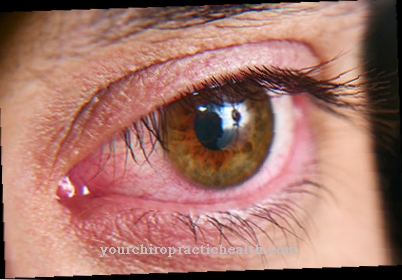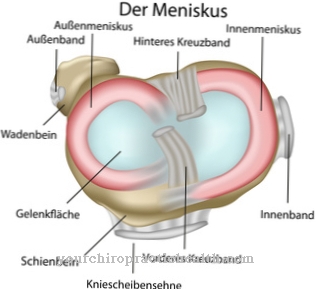Of the Ventricular septal defect (VSD) denotes a hole in the septum of the heart. Around a third of all congenital heart defects are ventricular septal defects. This makes the VSD the most common congenital heart defect.
What is a ventricular septal defect?
At the Ventricular septal defect it is a congenital (congenital) heart malformation. Of the VSD thus belongs to the heart defects. The heart septum between the two heart chambers has a hole so that the right and left heart chambers are connected to one another. The symptoms depend on the size of the defect. Smaller defects often close on their own within the first two years of life. Surgery may be required for larger defects.
causes
The causes of the ventricular septal defect are unknown. There is a defect in the septum of the heart (ventricular septum). The defect can be in different places. Most often it is found directly below the aortic valve. Muscular or perimembranous defects are less common. The blood from the left heart is pumped into the body and the blood from the right heart goes to the lungs.
Since the blood pressure in the pulmonary circulation is much lower than in the other body vessels, the left heart has to pump at a higher pressure. This means that there is also a greater pressure in the left ventricle than in the right ventricle. In this way, oxygen-rich blood flows from the left into the right ventricle via the ventricular septal defect. There is a so-called left-right shunt. That is why the VSD is also one of the shunt diseases.
Symptoms, ailments & signs
The consequences of this shunt depend on the size of the VSD. With a small defect, there are hardly any symptoms. Many of these defects are discovered only by chance. However, in medium and large ventricular septal defects, much of the arterial blood flows back into the right heart. This then pumps the blood back to the lungs.
The additional blood volumes increase the blood pressure in the vessels of the lungs. Pulmonary hypertension develops. The right heart has to pump against this increased blood pressure and therefore enlarges. This enlargement is known as right heart hypertrophy. The vessels of the lungs are not able to cope with the great pressure, so that they harden over time. These hardenings only make the situation worse.
The blood pressure in the lungs continues to rise and the right heart enlarges. At some point the right heart pumps so hard that the shunt is reversed. From now on, the blood no longer flows through the ventricular septal defect from the left to the right ventricle, but from the right to the left ventricle. The blood from the right ventricle comes from the body's circulation and is low in oxygen.
The body is therefore supplied with oxygen-poor blood. This gives the patient's skin a light blue color. The congestion of blood in the lungs can also lead to pulmonary edema. With pulmonary edema, fluid collects in the alveoli. The consequences are shortness of breath and coughing. Children with a VSD often show increased breathing. They do not drink well and grow only sparsely. Children with a VSD are often very slim.
Diagnosis & course of disease
During auscultation of the heart, a press-jet sound can be heard over the third to fourth intercostal space. However, as the size of the ventricular septal defect increases, this sound becomes quieter. If there is a large defect, a diastolic flow noise can occur as a result of the increase in blood pressure in the pulmonary circulation. The second heart sound is then split. The ECG is usually inconspicuous in the case of small defects.
With a larger ventricular septal defect, signs of left or right ventricular hypertrophy become visible. Chest x-rays for small defects are inconclusive. Otherwise there will be signs of pulmonary edema. The diagnosis is confirmed with the help of echocardiography. A cardiac catheter examination is also carried out in older patients to clarify the resistance relationships within the lungs.
Complications
Since the ventricular septal defect is a heart defect, it primarily has a very negative effect on the life expectancy of the person affected and can reduce it. As a rule, however, this case only occurs if the disease is not treated. Those affected primarily suffer from very high blood pressure, which can lead to a heart attack.
Permanent fatigue or exhaustion can also occur and have a very negative effect on the quality of life of the person concerned. The ventricular septal defect does not self-heal and the symptoms worsen over time. Since the body does not receive a normal supply of oxygen, those affected cannot participate in sports or strenuous activities.
Especially in children, this can lead to delayed or very limited development. Many patients also suffer from severe shortness of breath or a cough. The treatment of this disease is done with the help of medication and surgery. In most cases this can alleviate the symptoms. However, those affected depend on regular medical examinations in their lives so that there are no further complications.
When should you go to the doctor?
In the case of a ventricular septal defect, the patient depends on treatment by a doctor. Since this is a serious complaint of the heart, a doctor should be consulted at the first symptoms and signs of the disease so that there are no further complications or, in the worst case, death of the person concerned. As a rule, a doctor should be consulted in the case of a ventricular septal defect if the heart is beating very strongly even with little exertion. With high exertion or sporting activities, those affected usually notice the high pulse and thus also the high heartbeat.
Many patients also suffer from shortness of breath or a strong cough. If these symptoms occur over a longer period of time and do not go away on their own, an examination and treatment by a doctor is definitely necessary. The disease can be examined and treated by a cardiologist. Since this is a hereditary disease, genetic counseling should be carried out if you want to have children in order to prevent the disease from recurring. Whether this will lead to a reduced life expectancy cannot be universally predicted.
Therapy & Treatment
In a third of all infants with a VSD, the defect closes on its own within the first two years of life. In 20 percent of all infants it is at least smaller. Larger defects are fatal in a tenth of affected children within the first year of life. The children die from recurring infections of the bronchi and lungs or from acute insufficiency of the left heart. Since patients with larger ventricular septal defects often suffer from failure to thrive, they often have to be operated on in infancy. Otherwise, it is actually only waited to see whether the defect does not close by itself. The VSD can be operated in three different procedures:
- In the transatrial method, access is through the right atrium of the heart.
- Transventricular access is through the right ventricle
- and in the transarterial method, the access route is chosen through the pulmonary artery or the main artery (aorta).
The defect is then closed either with a suture or with a patch. Usually, a suture is avoided, as the resulting scar can later lead to cardiac arrhythmias. During the operation, the patients are connected to the heart-lung machine. If the ventricular septal defect is uncomplicated, one percent of children die.
The mortality rate is significantly higher in infants with heart failure. Complications occur in three to five percent of cases. The most serious complication is conduction disorder. The electrical excitation that is responsible for the contraction of the heart muscle is not transferred from the atrium to the ventricle.
prevention
A ventricular septal defect is difficult to prevent. However, alcohol and smoking are major risk factors for an unborn child to develop incorrectly and should therefore be avoided.
Aftercare
If the ventricular septal defect was closed surgically, follow-up treatment is required. This takes place initially in the hospital's intensive care unit. The patient is carefully observed. Because there is a catheter on one leg, it must not be moved independently at first. In addition, intense physical exertion should be avoided in the first week after the operation.
During the stay in the hospital and before the patient is discharged, the position of the locking system is checked, which is usually carried out as part of a transesophageal echocardiography (TEE). This procedure can be used to determine whether the attached occluder is correctly seated and whether the defect has also been correctly closed.
Some patients are at risk of blood clots forming on the occluder. These can be identified with the help of the TEE examination. If there is a clot, it is usually successfully resolved by administering appropriate medication.
To prevent another blood clot from forming, the patient takes medicines such as clopidogrel and aspirin for three to six months. Another check-up will take place after three to six months. Normally, you will not need to give any more medicine to prevent a blood clot.
The patient receives antibiotics as additional medication for the follow-up treatment of the ventricular septal defect. Their job is to prevent heart and vascular inflammation. If there are any abnormalities, a doctor must be informed immediately.
You can do that yourself
A small ventricular septal defect can close spontaneously after birth. The most important self-help measure for parents is to carefully observe the child and work closely with a cardiologist.
Larger defects must be closed surgically. After an operation, the child needs bed rest and rest. The parents must consult with the pediatrician and comply with his guidelines. In most cases, it is also necessary to adjust the child's diet. Weight loss needs to be compensated for by giving high fiber drinks. The child may need special supplements. In general, the child should be given sufficient fluids. Children with a ventricular septal defect should not exert themselves. Resting on the heart is particularly important in the first days and weeks after the operation.In consultation with the doctor, gentle movement is then allowed.
The actions to be taken with a ventricular septal defect depend on the size of the defect and the treatment method. The pediatrician specifies suitable measures and supports the child's parents during treatment and aftercare. Endocarditis prophylaxis must usually be followed for twelve to 16 months.



.jpg)

.jpg)





















